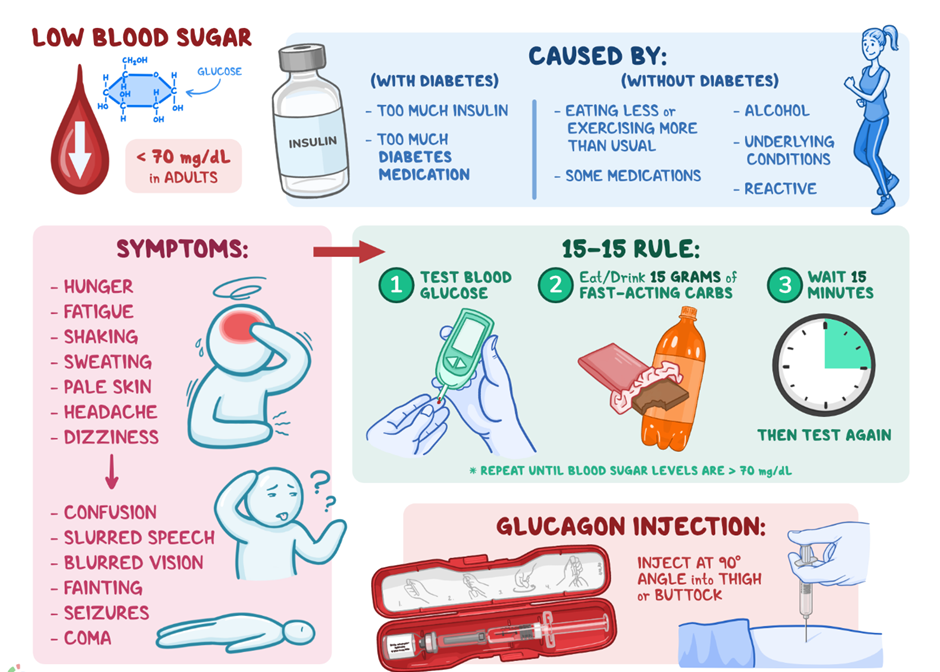A nurse is reinforcing teaching about manifestations of hypoglycemia with an adolescent who has type 1 diabetes mellitus. Which of the following manifestations should the nurse include in the teaching?
Diminished reflexes
Rapid respirations
Acetone breath
Headache
The Correct Answer is D
A. Diminished reflexes:
Explanation: Diminished reflexes are not typically associated with hypoglycemia. Instead, hypoglycemia may cause hyperactive reflexes or tremors.
B. Rapid respirations:
Explanation: Rapid respirations are not a common manifestation of hypoglycemia. In hypoglycemia, the body might respond with shallow, rapid breathing or hyperventilation.
C. Acetone breath:
Explanation: Acetone breath, often described as fruity or sweet, is associated with diabetic ketoacidosis (DKA), which is a complication of hyperglycemia rather than hypoglycemia.
D. Headache:
Explanation: Headache is a common manifestation of hypoglycemia. It can occur as a result of decreased glucose levels affecting the brain.

Nursing Test Bank
Naxlex Comprehensive Predictor Exams
Related Questions
Correct Answer is D
Explanation
A. Assist the client to low Fowler's position:
Placing the client in a semi-upright or low Fowler's position during and after the feeding helps prevent aspiration and facilitates digestion. This position reduces the risk of regurgitation and reflux.
B. Warm the feeding solution to body temperature:
Ensuring the feeding solution is at room temperature or slightly warmer can enhance the client's comfort and reduce the risk of cramping or discomfort caused by cold fluids.
C. Discard any residual gastric contents:
Before initiating a new feeding, it's essential to check and discard any residual gastric contents from the previous feeding to prevent contamination, ensure accurate measurement, and minimize the risk of bacterial growth.
D. Test the pH of gastric aspirate:
Checking the pH of gastric aspirate is an important step to confirm the proper placement of the NG tube in the stomach. Gastric pH is typically acidic (pH less than 5), indicating the correct placement of the tube in the stomach rather than the respiratory tract, where the pH is higher (more alkaline).
Correct Answer is C
Explanation
A. Hypertension:
Hypovolemia is characterized by a decrease in blood volume. This reduction in blood volume usually leads to decreased blood pressure, not hypertension.
B. Peripheral edema:
Edema is more commonly associated with hypervolemia (excess fluid volume) rather than hypovolemia. In hypovolemia, the body is experiencing a deficit of fluids, and edema is not a typical manifestation.
C. Oliguria:
This is the correct answer. Oliguria, or reduced urine output, is a common finding in hypovolemia. When the body is low on fluids, the kidneys try to conserve water by decreasing urine production.
D. Bradycardia:
Hypovolemia often leads to tachycardia (an increased heart rate) as the body attempts to compensate for the decreased blood volume by pumping the existing blood more quickly. Bradycardia is not a typical finding in hypovolemia.
Whether you are a student looking to ace your exams or a practicing nurse seeking to enhance your expertise , our nursing education contents will empower you with the confidence and competence to make a difference in the lives of patients and become a respected leader in the healthcare field.
Visit Naxlex, invest in your future and unlock endless possibilities with our unparalleled nursing education contents today
Report Wrong Answer on the Current Question
Do you disagree with the answer? If yes, what is your expected answer? Explain.
Kindly be descriptive with the issue you are facing.
